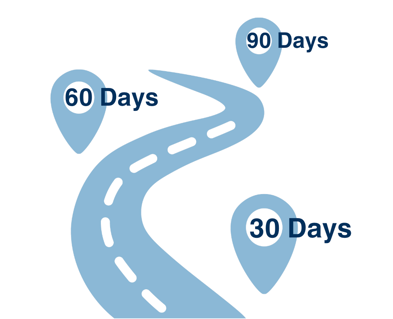The Executive Leadership Playbook: How C-Suite Leaders Drive Sales Growth
Written by: Mike Carroll

Most companies treat sales as a separate department—something that happens "over there" while the rest of the organization focuses on their core functions. This departmental thinking creates one of the most expensive blind spots in business: the untapped revenue potential of strategic executive involvement in sales.
While sales teams struggle with interdepartmental friction, missed forecasts, and longer sales cycles, C-suite executives often stand on the sidelines, either avoiding sales activities entirely or jumping in at the wrong moments in counterproductive ways.
The result? Deals that should close don't. Revenue that should accelerate stagnates. Growth that should compound stays linear.
But here's what most sales content won't tell you: Every executive is already impacting sales—the question is whether that impact is helping or hindering revenue growth.
When executives strategically engage with sales, the results multiply exponentially. Shorter sales cycles. Higher win rates. Stronger customer relationships. More predictable revenue growth. The executives who master this become force multipliers for their entire organization.
But how do we give C-suite leaders a clear framework for how to contribute effectively based on their unique background, comfort level, and skill set? Let’s dive in.
Where You Stand Depends on Where You Sit: The Executive Background Effect

Your career background before becoming an executive profoundly shapes how you view sales. Understanding these built-in biases is the first step toward optimizing your sales impact.
The Marketing Executive Perspective
Executives with marketing backgrounds bring deep customer understanding but tend to view sales through a features-and-benefits lens. They believe the next product release or perfect demo will solve sales challenges, emphasizing storytelling over the questioning skills that build demand and create urgency in prospects.
The Finance Executive Challenge
Finance-background executives view sales as an expense to be managed rather than an investment with measurable returns. They're reluctant to invest in talent, training, or technology while expecting high margins and exceptional results, creating a self-fulfilling prophecy of underinvestment and frustrated teams.
The Operations Executive Advantage
Operations executives expect sales to follow predictable workflows and get frustrated when deals don't progress linearly. However, they appreciate structure and systems, making them exceptional allies when you demonstrate how sales follows certain milestones. They understand ROI and willingly invest in sales technology and processes as productivity enhancers.
The Sales Executive Paradox
Sales-background executives fall into two camps: The Underminer shares outdated war stories and jumps into deals mid-cycle with techniques that no longer work. The Strategic Delegator recognizes that markets evolve and delegates effectively while remaining strategically available when needed.
The Legal Executive Mindset
Legal executives view the world as risks to be managed, creating overly complicated contracts and processes. They typically optimize for avoiding bad outcomes rather than creating good ones, making them risk-averse operators rather than growth-focused leaders.
The Technology Executive Perspective
Technical executives are feature-benefit oriented and risk-averse, but their rigor around requirements can be an asset when properly channeled into the sales process.
The Executive Sales Involvement Grid: Your Diagnostic Tool

Most executives avoid sales not because they don't want to help, but because they don't know where they fit or how to contribute effectively. The Executive Sales Involvement Grid provides a clear diagnostic tool for assessing your current position and charting your development path.
The grid measures two critical dimensions:
|
Vertical Axis: Comfort with Sales |
Horizontal Axis: Selling Skills |
|
|
This creates four distinct quadrants, each requiring different strategies and offering different opportunities.
Support Quadrant: High Comfort, Lower Skills
Executives in this quadrant are comfortable with sales interactions but lack specific selling skills. They're willing to engage but need structured ways to contribute effectively.
Optimal Activities:
- Post-sale thank you calls: After deals close, make CEO-to-CEO calls to introduce yourself, open communication lines, and ensure smooth project launches
- Relationship maintenance: Mid-cycle "love bombing" where you compliment the prospect's team to their leadership
- Strategic introductions: Use your network to open doors and create warm connections
- Deal review participation: Conduct regular deal reviews, provide feedback, and ask strategic questions about the sales process
Development Path: Focus on building specific selling skills while leveraging your natural comfort. Start with low-stakes activities like association speaking or joining calls in a supporting role.
Drive Quadrant: High Comfort, High Skills
These executives are comfortable with sales and have strong selling capabilities. They should be directly involved in strategic sales activities.
Optimal Activities:
- Market testing: Lead experimental sales efforts in new markets or with new products before committing full resources
- Strategic deal involvement: Lead complex negotiations and high-stakes customer conversations
- Sales team mentoring: Directly coach high-potential salespeople and sales leaders
- Process innovation: Refine sales methodology and messaging based on direct market experience
- Lead by example: Take active role in sales activities, prospecting, and CRM management to model best practices
Key Principle: Know when to lead and when to support. Your involvement should amplify the sales team's efforts, not replace them.
Invest Quadrant: Lower Comfort, Lower Skills
Executives here recognize their limitations and should focus on enabling others through strategic investments.
Optimal Activities:
- Marketing investments: Fund lead generation efforts and systems to support growth
- Technology investments: Upgrade CRM systems, sales tools, and automation platforms
- Talent investments: Hire experienced sales leadership and invest in team development
- Process investments: Implement coaching systems, accountability frameworks, and sales methodologies
Development Path: Begin building comfort through structured activities like internal role-playing or attending sales team meetings as an observer.
Stretch Quadrant: Higher Comfort, Lower Skills
These executives are comfortable with sales interactions but need to develop specific selling capabilities.
Optimal Activities:
- Association speaking: Join industry panels to generate leads while building speaking skills
- Ride-along support: Attend customer calls in a supporting role, handling introductions and closing remarks
- Strategic relationship building: Focus on networking and relationship development rather than direct selling
- Sales team role-play: Lead practice scenarios and coaching sessions to develop sales skills while helping your team
- Eagle-to-eagle calls: Contact executives at prospects or lost opportunities to gather strategic feedback and show executive commitment
Development Path: Gradually build selling skills through structured learning while leveraging existing comfort levels.
Role-Specific Impact Strategies
While the grid provides your development framework, specific roles within the C-suite have unique opportunities to drive sales results.

CEO Impact Opportunities
In the Support/Stretch Quadrants: Implement a systematic thank-you call process. After major deals close, make a brief CEO-to-CEO call:
"I wanted to personally thank you for choosing us. Here's my direct number, and here's how to reach my assistant. Let's maintain open communication as we work together."
This two-minute investment creates tremendous goodwill and opens executive-level communication channels that prevent small issues from becoming major problems.
In the Drive Quadrant: Lead market validation efforts before major investments. Test new products, services, or markets personally before deploying full sales resources. Your executive credibility can open doors and gather feedback that wouldn't be available to sales team members.
Conduct lost-deal analysis calls with executive counterparts. You'll receive candid feedback about competitive weaknesses, pricing issues, or capability gaps that prospects won't share with salespeople.
CFO Collaboration Strategies
The key for CFOs is shifting from expense management to investment thinking. Instead of asking "How much will this cost?" ask "What return can we generate?"
Financial Impact Analysis: Help your sales team articulate how your solutions impact customers' financial statements. Can you reduce labor costs? Improve efficiency? Accelerate cash flow? CFOs who can teach salespeople to speak in financial terms dramatically improve deal quality and closing rates.
Flexible vs. Rigid Approach: The fundamental question for finance leaders: Are you looking for ways to approve deals or for reasons to reject them? Flexible CFOs find creative payment terms, accept reasonable credit risks, and structure deals that work for both parties. Rigid CFOs create bottlenecks that kill momentum and frustrate sales teams.
CMO and COO Sales Support
Marketing Alignment: Test new messaging with your sales team before launch. They'll immediately identify what resonates with prospects and what falls flat. Work directly with sales to define qualified leads. Keep in mind, marketing's definition often differs dramatically from sales' reality.
Operations Integration: When supply chain or capacity constraints threaten deals, find ways to de-risk situations for prospects. Bring technical expertise into the sales process rather than waiting until contracts are signed to discover operational mismatches.
Solving Interdepartmental Friction: From Rigid to Flexible

Most interdepartmental friction stems from a fundamental mindset difference: are you looking for ways to say "yes" or finding reasons to say "no"?
The Legal Collaboration Framework
Legal teams typically enter sales processes two-thirds of the way through the funnel, when contracts need review. The question becomes: Is your legal team looking for ways to make deals work, or are they defending against every possible risk?
|
Flexible Legal Approach |
Rigid Legal Approach |
|
|
Finance Team Flexibility
Finance friction often centers on credit approvals and payment terms, but the deeper issue is expense reports and administrative support.
For example, salespeople work differently than office-based employees. They're traveling constantly, working weekends, and handling last-minute customer emergencies. Their expense reports might be late or incomplete, but they're also working 24/7 to drive revenue.
Flexible Finance Approach:
- Recognize that sales schedules don't align with administrative deadlines
- Focus on material impacts rather than minor procedural violations
- Create systems that accommodate travel-based work styles
- Support sales team needs while maintaining necessary controls
Marketing-Sales Partnership
The most common friction point: lead quality disagreement.
|
Marketing Perspective |
"We're generating lots of leads with great open rates and attendance." |
|
Sales Perspective |
"These leads are garbage, no decision-makers in the group." |
Solution Framework:
- Align on qualified lead definitions before campaign launch
- Include sales feedback in campaign design
- Focus on decision-maker engagement, not just volume metrics
- Create feedback loops for continuous optimization
Operations Integration
Operations leaders often view sales through the lens of process control and predictable timelines. The key question becomes: Are you adapting operational capabilities to support sales momentum, or forcing sales to conform to rigid operational constraints?
|
Flexible Operations Approach |
Rigid Operations Approach |
|
|
The most effective operations leaders recognize that small process modifications during sales cycles can prevent major delivery problems later, while rigid operational thinking often creates sales obstacles that could easily be avoided.
Executive Escalation: When and How to Get Involved
Strategic executive involvement accelerates deals. Poorly timed or executed involvement kills them.
The Reframing Questions Technique
When departments claim something is impossible, use reframing questions to unlock creative thinking:
- Instead of accepting: "There's no way we can meet that timeline."
- Ask: "I know you feel like you can't yet. What would happen if you could?"
- Follow with: "What would need to change for you to deliver in eight weeks instead of twelve?"
This approach acknowledges current constraints without accepting them as permanent, opens possibility thinking, and moves conversations from problems to solutions.
Warning Signs: When Executives Become Bottlenecks
Micromanagement Red Flags:
- Jumping into deals mid-cycle without sales team input
- Undermining established methodology or messaging
- Creating last-minute changes to contracts or pricing
- Bypassing sales leadership for direct customer contact
Course Correction Strategy: Strong sales leadership must provide direct feedback when executive involvement becomes counterproductive. This requires clear boundaries about when and how executives engage, regular communication about deal status, and defined escalation protocols.
Building an Integrated Executive Sales System

The ultimate goal isn't just better executive sales involvement. It's creating an organization where everyone understands their role in driving revenue growth.
The Mindset Transformation
Most people's first word association with "salesperson" is negative: pushy, aggressive, annoying, smarmy. These perceptions directly impact how executives interact with their sales teams.
Reframe sales teams as helpful problem solvers. If you believe in your product and know you can help customers, then your sales team is out there trying to solve problems for people who need what you offer.
This reframing changes everything:
- How do we make contracts easier so we can help more people?
- How do we minimize risk while finding ways to say yes?
- How do we generate better leads for our problem solvers?
- How do we give them better tools to solve customer problems?
Creating Revenue Team Accountability
Instead of departmental silos competing for resources, create a revenue team mentality:
- Everyone is invested in pipeline success
- Departments proactively ask "How can we help you win this deal?"
- Internal conflicts focus on problem-solving, not blame assignment
- Success metrics include revenue impact, not just departmental efficiency
The Collaborative Support Model
For Sales Teams Seeking Executive Support:
Wrong Approach: Complaining about lack of support
- "Legal is fighting us on everything"
- "Finance won't approve reasonable deals"
- "Marketing leads are terrible"
Right Approach: Collaborative problem-solving
- "I need your help with something. Can I ask for your support?"
- "My team is struggling with [specific issue]. Here's what we need from you."
- "What are the biggest risks you're trying to mitigate? How can we work together on this?"
- "How do we look at prospect requests and find ways to make them work?"
This approach engages executives as partners rather than adversaries.
Implementation Roadmap
30-Day Quick Wins
Week 1-2: Assessment
- Complete the Executive Sales Involvement Grid assessment
- Identify your quadrant and development opportunities
- Audit current interdepartmental friction points
- Survey sales team about support needs
Week 3-4: Initial Actions
- Support/Drive Quadrants: Implement thank-you call process for recent deals
- Invest/Stretch Quadrants: Schedule meetings with sales leadership to identify investment priorities
- All Quadrants: Begin attending weekly sales meetings as observer
60-Day Development Phase
Month 2 Focus Areas:
|
Support Quadrant
|
Drive Quadrant
|
|
Invest Quadrant
|
Stretch Quadrant
|
90-Day Transformation
Quarter 1 Outcomes:
Integrated Executive Sales System:
- Clear escalation protocols established
- Regular cross-departmental sales support meetings
- Flexible vs. rigid mindset adopted across leadership team
- Measurement systems tracking executive sales involvement impact
Individual Development:
- Movement toward Drive quadrant for all executives
- Specific skill development based on starting position
- Collaborative relationship between all departments and sales
- Regular feedback loops between sales team and executive leadership
Measuring Success
Leading Indicators:
- Reduced sales cycle length
- Improved interdepartmental collaboration scores
- Increased sales team retention
- Higher customer satisfaction during sales process
Lagging Indicators:
- Improved win rates
- Increased average deal size
- Higher customer lifetime value
- More predictable revenue growth
Warning Signs:
- Sales team requests for less executive involvement
- Increased interdepartmental conflict
- Customer feedback about confusing or conflicting messages
- Longer decision-making cycles
The Revenue Multiplier Effect

Companies with strategically involved executives don't just sell more, they sell differently. Their sales cycles are shorter because internal alignment eliminates delays. Their win rates are higher because customer-facing teams present unified value propositions. Their growth is more predictable because everyone in the organization understands their role in driving revenue.
The most successful organizations recognize a fundamental truth: everyone is in sales at some level.
The executives who master strategic sales involvement become force multipliers for their entire organization. They turn departmental friction into collaborative advantage. They transform risk-averse thinking into customer-focused solutions. They create cultures where everyone is invested in revenue success.
Your sales team is already working hard to drive results. The question is: are you making their job easier or harder? Are you accelerating deals or creating obstacles? Are you helping solve customer problems or adding layers of complexity?
The choice is yours. The framework is here. The results are waiting.
Ready to transform your executive team into revenue multipliers? If you're seeing interdepartmental friction, inconsistent sales results, or untapped growth potential, let's talk. Book a strategy call to discuss how we can help your leadership team drive the revenue growth your organization deserves.
Related Articles:
Golden Rule of Sales Leadership
Do you remember the golden rule you learned in 1st grade?
Ready to Build a High-Performing Sales Team?
Let's create your custom Sales Transformation Program.

